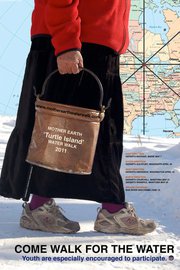I know a lot of Canadians would be ashamed to know that in Canada — on Turtle Island — there are people living on this land who do not have access to clean drinking water.
Sure, I know most people reading this are looking around right now, sure that there is a tap or drinking fountain nearby where they can safely take a sip of water or wash out a cup.
Most Canadians take for granted that for them, access to clean water is a given.
Clean water comes from the pipes just as milk comes from a grocery store, with little sense of the connection to the earth from which the waters flow.
Imagine if that Canadian-given access to clean water were to no longer exist — because of our own pollution and lack of accountability for our actions as humans on the earth?
There would be general panic, massive outrage and moral pontifications from citizens, demanding immediate action from Ottawa to remedy the problem.
So let me tell you now that there are people living in Canada who do not have access to clean drinking water.
But as most Canadians live safely tucked away in cities, they are the invisible “others” who live on Canada’s reserves. Out of sight. Out of mind. Wrong demographic. Wrong skin colour.
While First Nations communities across Canada have been begging for clean water, there has been no panic, massive outrage or moral pontifications from citizens demanding immediate action from Ottawa to remedy the problem.
Nor has there been any outrage or concern expressed by the federal government or the opposition while it sat in parliament or now on the campaign trail.
Frankly, most Canadians don’t even think about their fellow Canadians who don’t have access to clean water as they pour themselves a drink, nor thank the earth from where the water came.
According to a CBC report, “As of Feb. 28, 2011, 116 First Nations communities across Canada were under a drinking water advisory. Health Canada won’t provide a list of them, citing privacy concerns. CBC News has obtained one from Aug. 31, 2010, which sources say is still current.
There are more communities on that list now than in 2006, when a CBC News investigation first looked at this issue, despite the fact that the Department of Indian Affairs will have spent $2.5 billion dollars to improve drinking water access on First Nations by 2013.”
Right now, during this federal election, I have yet to see any politicians making the effort to join or major news organization running a story about the Mother Earth Water Walk 2011, while Anishinaabe grandmothers, women, men and youth from Canada and the United States are walking to protect the water — from us.
The message:
“ni guh izhi chigay nibi onji” (Ojibwe)
“I will do it for the water” (English)
“Je le ferai pour l’eau” (French)
“Nin tla’teka’s wu’jit samquan” (Mi’kmaq)
“Biish maandah waanda zhitch gayon” (Odawa J)
The Mother Earth Water Walk began in 2003 in answer to question — “What will you do?”
What will you do to help protect the water?
Luckily for the rest of us, some of us two-legged (humans) have been brave enough to answer this question and take up the call to protect the water. Thus, the idea of a Mother Earth Water Walk became a reality.
The Water Walk 2011 began on April 10, 2011 from Aberdeen, WA, and then, “the walkers, journeying over 10,400,000 steps and carrying the healing and sacred salt water from the four directions will converge June 12 in Bad River, Wisconsin. The water will then be united in Lake Superior, where the first Water Walk began.” You can view the schedule here.
From the Mother Earth Water Walk call out, “The 11,525 miles or 18, 549 kilometers were walked to call attention to the sacred gift of water, the source of our life, the source of all life. The past walks also raised awareness of the need to take care of the water, and to help our Mother Earth who is struggling to survive and to provide for all her children.
Each of the 24,113,700 steps taken was a prayer for the water, for Mother Earth, for the animals, the birds, the insects, the trees and for us, all two leggeds. Together the walks were one prayer for life.
This spring the Water Walk returns and the prayer continues. The 2011 Water Walk unites all the waters of our Mother Earth — beginning on April 10, 2011.
As the northern snows begin to melt and further south spring rains fall, our Mother Earth awakens and new life begins.
Water from the vast Pacific Ocean, from the Gulf of Mexico, from the Atlantic Ocean and from Hudson Bay will be gathered in copper pails and carried by hand to the shores of Lake Superior. Ocean water from the four directions will travel the miles with Anishinaabe women and men walking side by side.”
So take a break from the noise of the election and now ask yourselves: What will you do to help protect the water?
For more information on how you can get involved in the Mother Earth Water Walk, please check in at these following sites:
www.motherearthwaterwalk.com (Background information)
www.emptyglassforwater.ca/map (Please check the map to see what the needs are for the walkers)
Facebook: Water Walk 2011 (Photos, videos, good wishes)
Or email [email protected] (Please email us your best wishes for the Water and the Water)
All people are encouraged and welcome to participate in and to support the 2011 Water Walk as it passes through their provinces, states and communities.




